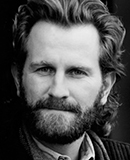
Henry Woronicz first came to OSF in 1984 as an actor and in 12 seasons at OSF he played numerous roles, including Mark Antony in Antony and Cleopatra, Petruchio in The Taming of the Shrew, Peer in Peer Gynt, and many more. He directed numerous productions as well, including Pravda, Hamlet, The Rehearsal, Cymbeline, All’s Well that Ends Well, La Bête, Other People’s Money, The Second Man, Henry IV, Part Two, Romeo and Juliet, “Master Harold”…and the boys, and Sea Marks.
In June 1991, Henry accepted the appointment of Artistic Director, succeeding Jerry Turner. In accepting the challenge of Artistic Director he envisioned a redefinition of OSF’s three theatres—on the Allen Elizabethan Theatre a greater reliance on the unadorned façade and the power of Shakespeare’s words; in the Black Swan, a return to the space’s original mission, to be a place where “we can fail and take risks,” and to that end it would no longer be a “mini-Bowmer,” but a spare arena with minimal scenic elements where the focus would be on the relationship of actor, text, director and audience; and the Angus Bowmer Theatre would remain the theatre where anything could be done.
In order to help accomplish his goals he expanded the artistic office to include Pat Patton as Associate Artistic Director, Kirk Boyd as Associate Director/Production and Cynthia White as Associate Director/Play Development. Cynthia, in particular, would help with Henry’s commitment to new play development. In a 1991 inter-view he said, “Our house playwright is a great writer, and I think a classical theatre has a certain obligation to nurture writers because there will be classics in the future that will have to be done.”
Henry was committed to increasing the diversity of the acting company and to multicultural casting. It troubled him that during one season people of color were represented on stage and then the next season there was no diversity. In 1991, people of color represented only one percent of the acting company. By 1995 that number had risen to 25 percent. In addition, OSF increasingly produced stories of people of color—August Wilson’s Joe Turner’s Come and Gone (1993); George C. Wolfe’s The Colored Museum (1994), Dr. Endesha Ida Mae Holland’s From the Mississippi Delta (1995) and Federico García Lorca’s Blood Wedding (1995).
Henry also hired more women directors and was the first to hire a woman as associate artistic director (Fontaine Syer, 1993-1995) and in doing helped pave the way for OSF’s first female artistic director, Libby Appel. In addition he added more actor resources, hiring voice and text coaches, a movement director and dramaturges. His influence continues, and today OSF hires artists to fill these positions for each production team.
At the time of taking on the job of AD, Henry noted that he was inspired by three men of the theatre. First was Laurence Olivier, who was both actor and director, and Henry, too, continued to act and direct in order to be “in the heart of the company.” Second was Jim Edmondson, long time OSF company member and actor and director: “Jim’s nurturing quality is something that I try to incorporate into my work,” Henry said. And lastly, Jerry Turner: “I have a great admiration for his honesty. He strikes me as one of those great artists of the soul, someone who demands constant investigation of this life.”
Henry left the position of Artistic Director at OSF in 1995 and has continued to act and direct in regional theatre throughout the country. He served as Executive Producer for the Lake Tahoe Shakespeare Festival for the 2009 season, a one year consultation. He is currently the Head of the MFA Acting Program at Illinois State University in the School of Theatre.